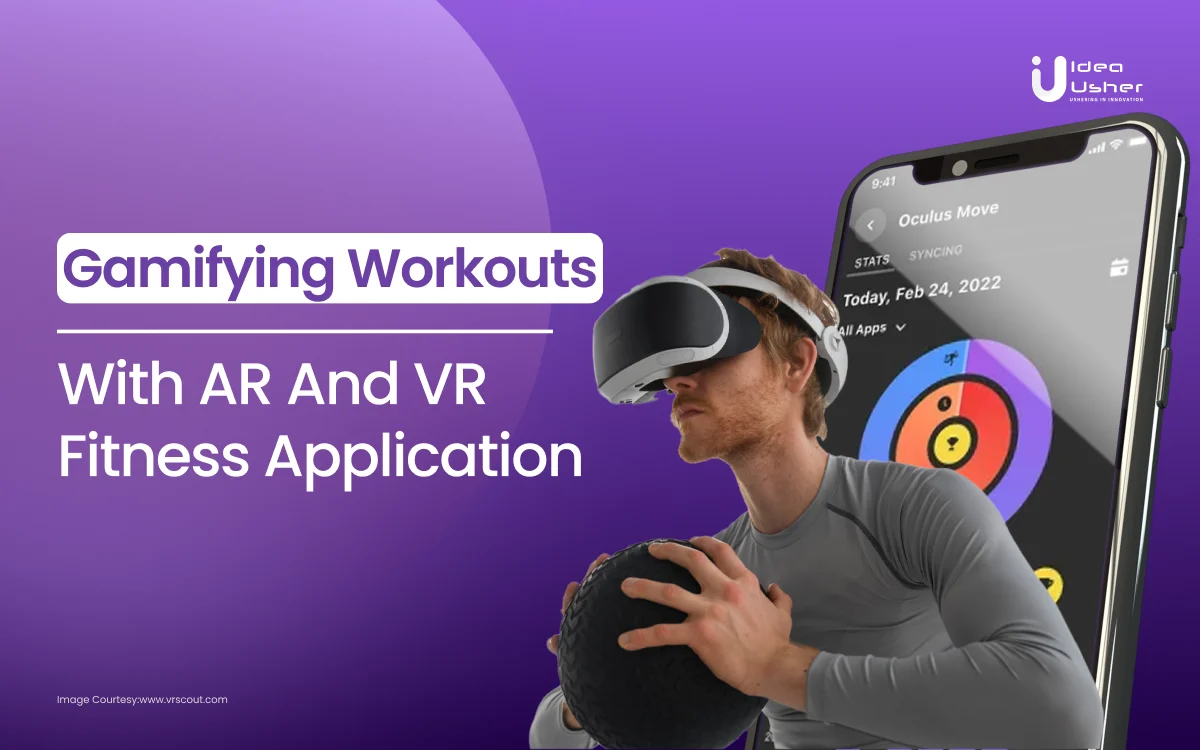
Through the increasing integration of augmented reality (AR) and virtual reality (VR), technology, which is frequently viewed as a barrier to physical exercise, is revolutionizing the fitness business.
Far from being opponents of exercise, these technologies are emerging as critical tools in gyms and fitness clubs, increasing users’ enjoyment of exercise while contributing to higher revenues.
Augmented reality (AR) seamlessly integrates digital content into an individual’s real-world environment, adding an intriguing dimension to their surroundings. Businesses are capitalizing on this technology to captivate consumers and expand their customer base, notable examples being the widely used AR features in platforms like Snapchat and Instagram filters.
Virtual Reality, on the other hand, is loved for the immersive. experience that it offers. You could be cycling or running anywhere worldwide by just wearing a simple VR headset. The sounds and the visuals are as good as any real experience.

Source: Statista
VR and Augmented Reality workout apps have also witnessed an increase in users during the pandemic. Even people on a strict fitness regime could not hit the gyms, and the situation has not improved. In such cases, augmented and virtual reality mobile fitness apps are assisting people in reaching their fitness goals.
In this article, discover how AR and VR apps gamify the workout experience and propel fitness businesses toward new heights.
How AR and VR Fitness Apps Are Gamifying Workouts?- Gamification Elements In Fitness Apps
- Examples Of AR In Workout Gamification
- Examples Of VR In Workout Gamification
- Must-Have Features In AR & VR Fitness Apps
- How To Integrate AR and VR Into Fitness Apps?
- Tech Stack To Consider For Integrating AR and VR Into Fitness Apps
- Conclusion
- How Idea Usher Can Help With AR & VR Development?
- FAQ
How AR and VR Fitness Apps Are Gamifying Workouts?
AR and VR fitness apps have revolutionized how individuals engage with their workout routines, introducing an element of gamification that transcends traditional exercise methods. In this exploration, we delve into these innovative technologies’ diverse applications and benefits, demonstrating how they infuse entertainment into fitness, making it an enjoyable and immersive experience.
1. Sustained Motivation
One of the significant challenges in fitness is maintaining consistent motivation. AR and VR workout apps address this hurdle by integrating gamified elements, allowing users to participate in virtual competitions, share progress socially, and compete with peers. The competitive nature of these virtual experiences captivates users, fostering concentration and enjoyment in the workout process. Additionally, users can strive to beat their own high scores, providing an ongoing source of motivation.
2. Achievable Goal Setting
Similar to personal trainers at the gym, AR and VR fitness apps assist users in setting achievable goals. These goals, tailored to the individual’s fitness level and progress, encourage steady improvement. As users surpass initial challenges, they move closer to their fitness objectives. This goal-setting aspect emulates the guidance provided by a personal trainer, creating a structured and effective workout routine.
3. Personalized Exercise Recommendations
AR and VR fitness apps offer personalized workout routines based on user data, including BMR, age, and body weight. These apps track activities and design challenging routines to maximize outcomes. This tailored approach ensures that users engage in exercises suitable for their body’s specific needs, promoting efficiency in achieving fitness goals.
4. Flexible Schedule Integration
Virtual workout apps provide flexibility, allowing users to exercise according to their schedules. Unlike fixed gym hours, these apps adapt to the user’s availability, ensuring that the workout routine aligns seamlessly with their daily timetable. This flexibility encourages consistent participation, making it easier for individuals to incorporate exercise into their routines.
5. Entertaining Workouts
Incorporating gamification into fitness through AR and VR apps transforms exercise into an entertaining and engaging activity. Users can burn calories while playing virtual reality games, blending leisure with health benefits. This fun element encourages prolonged participation and a positive attitude towards physical activity.
6. Health Tracking Tools
In an era of sedentary lifestyles, AR and VR fitness apps are valuable tools for tracking health conditions. These apps guide users on appropriate workout types and intensity based on individual health parameters. Users receive optimized workout solutions by inputting relevant data, promoting overall health awareness and proactive fitness management.
7. Virtual Exploration
The immersive nature of virtual reality setups in fitness apps opens new possibilities for exploration. Users can virtually visit different environments, run on a beach, or cycle in the mountains, enhancing the overall workout experience. The ability to see, hear, and feel various scenarios makes exercising adventurous and adds a dynamic dimension to traditional fitness routines.
Gamification Elements In Fitness Apps
The objective of integrating gamification into workouts is to maintain user engagement by providing rewards as they advance through the narrative of the fitness app. Here are the gamification elements in workout:
1. Achievements
In the context of workout gamification, achievements serve as a powerful motivator by providing users with tangible recognition for completing specific tasks or reaching milestones. These could range from accomplishing a certain number of workouts in a week to mastering a challenging exercise routine. By incorporating achievements into fitness apps, users experience a sense of accomplishment, fostering a positive feedback loop that encourages continued engagement and progress. The psychological impact of earning achievements aligns with the intrinsic motivation often associated with successful gamification strategies, making it a key component in enhancing the overall user experience.
2. Points
Assigning points for various activities within a fitness app adds an element of competition and progression. Users can earn points for completing workouts, watching instructional videos, or consistently logging their exercise routines. The accumulation of points not only quantifies users’ efforts but also introduces an element of challenge, motivating them to continually strive for higher scores. Points can be used as a universal metric to track overall fitness progress, creating a gamified environment that transforms routine exercises into a dynamic and goal-oriented experience.
3. Ranks and Leaderboards
Ranks and leaderboards introduce a social and competitive dimension to workout gamification. Users can compete with others, striving to achieve higher ranks on leaderboards based on factors such as workout frequency, points earned, or overall fitness achievements. This element taps into individuals’ innate desire for recognition and status, encouraging friendly competition and fostering a sense of community within the fitness app. By visualizing their progress relative to peers, users experience a heightened motivation to stay committed to their fitness goals.
4. Levels
Structured as a progression system, levels in workout gamification represent a tiered approach to content delivery and difficulty. Users start at lower levels, mastering foundational exercises and concepts, and progress to higher levels as they advance. Each level introduces new challenges, workouts, or educational content, ensuring a continuous learning curve. This tiered structure provides a sense of accomplishment and mastery, keeping users engaged and invested in their fitness journey as they unlock progressively more advanced stages within the app.
5. Peers
The social aspect of gamification is amplified through the inclusion of peers in the fitness journey. Users can connect with friends, share achievements, and engage in collaborative challenges. This external component taps into the power of social validation, making the fitness experience more enjoyable and addictive. The supportive network of peers creates a sense of community, where individuals encourage each other to achieve their fitness goals. By integrating social elements, workout gamification becomes a shared experience, enhancing motivation through positive reinforcement and friendly competition.
Examples Of AR In Workout Gamification
Explore a compilation of groundbreaking AR fitness apps that utilize state-of-the-art technology to enhance the workout experience and maintain user motivation.
1. Zombies, Run!
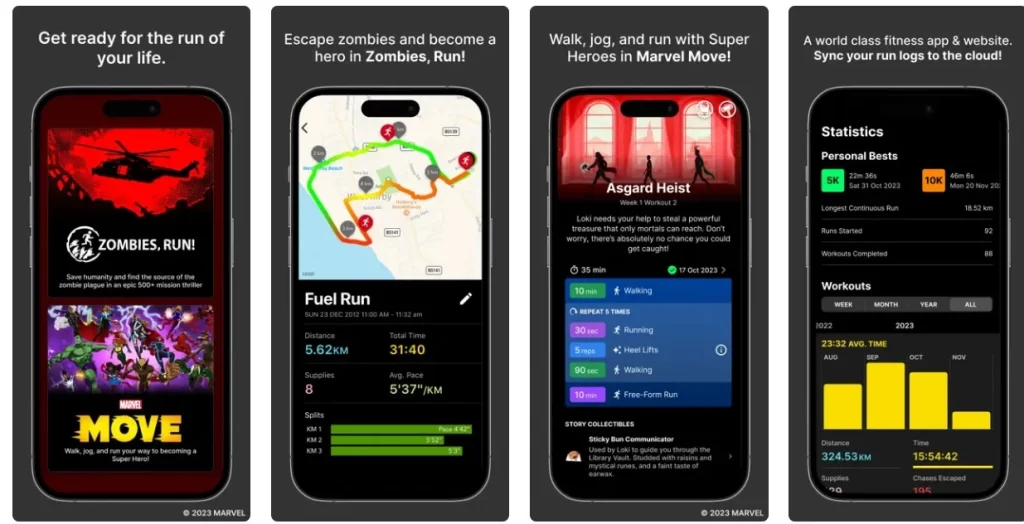
A standout example of AR fitness apps is “Zombies, Run!” This innovative running app transforms traditional jogging sessions into thrilling experiences. Users immerse themselves in a zombie apocalypse scenario, receiving instructions from a virtual helicopter pilot as they navigate the environment. The app blends real-world running with digital storytelling, adding an exciting layer to fitness routines and making workouts engaging and dynamic.
2. Prayoga
“Prayoga” is an AR yoga app that leverages body tracking technology to enhance the yoga experience. Users receive real-time feedback on their yoga poses, ensuring proper alignment and form. Particularly noteworthy is the integration with Apple Watch, allowing seamless synchronization of workouts with iPhones using ShazamKit. This app demonstrates how AR can be employed to provide interactive guidance, making yoga practice more effective and personalized.
3. Golfshot
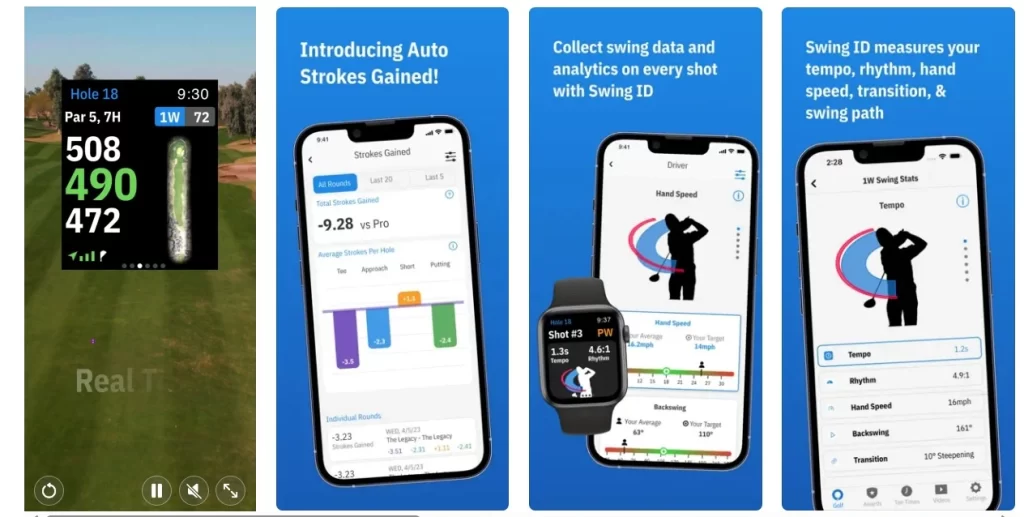
For golf enthusiasts, the award-winning “Golfshot” app brings AR to the golf course, enhancing the overall playing experience. Users can utilize their phones to access real-time information about targets and hazards on the course. Additionally, the app offers recommendations on which clubs to use, leveraging AR technology to provide valuable insights and improve decision-making during a round of golf. “Golfshot” showcases how AR can be integrated into sports apps to offer practical assistance and enhance the user experience.
4. Gymnotize
“Gymnotize” is a training app that utilizes AR to guide users in weightlifting exercises. The app goes beyond conventional workout apps by providing real-time visualizations of proper form and technique. Users receive instant corrections, ensuring they perform exercises with precision and reduce the risk of injury. With its focus on form correction through AR, “Gymnotize” exemplifies how technology can play a crucial role in improving the effectiveness and safety of strength training workouts.
Examples Of VR In Workout Gamification
Virtual Reality (VR) has emerged as a transformative force, revolutionizing traditional workout routines. This section explores VR fitness apps, showcasing how immersive technology is reshaping the fitness industry, and making workouts engaging and effective.
1. Eleven VR Table Tennis
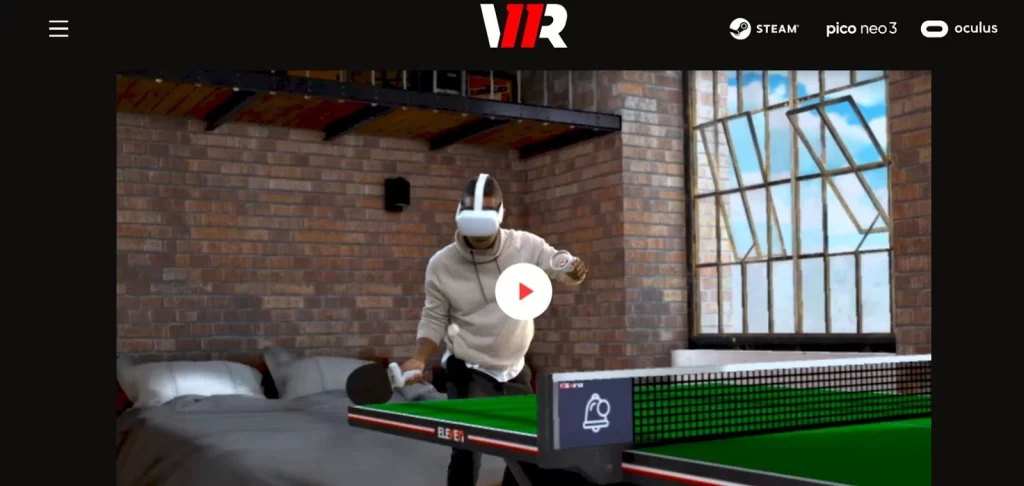
“Eleven VR Table Tennis” stands out as a fully immersive VR fitness app, offering a unique and intense workout experience through ping pong simulation. Users can engage in skill-building sessions with a trainer, play single-player games, or compete with other players online. The game’s combination of physical movement and virtual gameplay contributes to a high-intensity workout, demonstrating the potential of VR in making fitness enjoyable and engaging.
2. Supernatural VR Fitness
“Supernatural VR Fitness” combines physical exercise with immersive virtual environments. Initially focusing on their “Flow” workout, which incorporates striking targets and performing squats and lunges to music, the app has expanded to include boxing, meditation, and stretching sessions. Integrating popular music and diverse workout routines, “Supernatural” demonstrates how VR can diversify fitness experiences, catering to various preferences and fitness goals.
3. VZFit
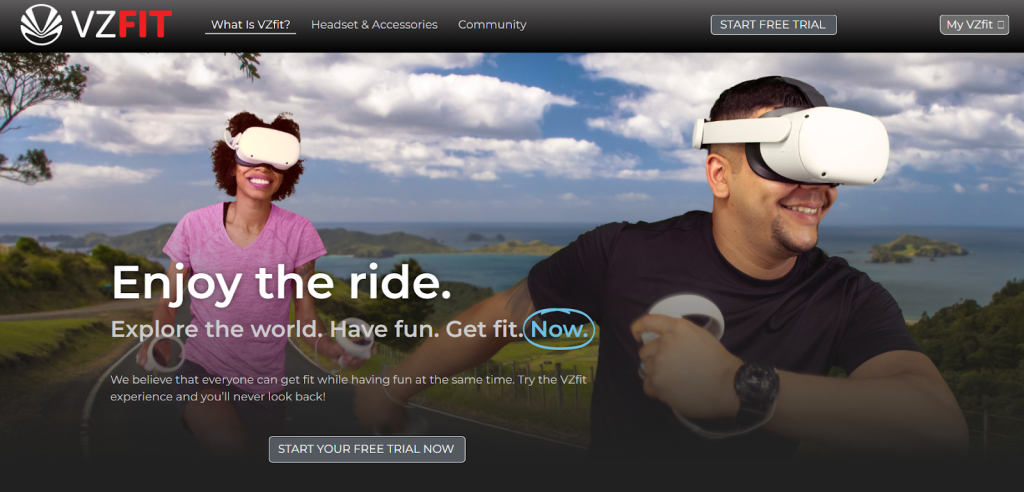
“VZFit” takes VR fitness to another level by connecting to a sensor on a stationary bike. This innovative app allows users to cycle through picturesque landscapes like Ireland, the Alps, or Paris, providing a scenic and immersive alternative to traditional indoor cycling. By transforming stationary bike workouts into virtual adventures, “VZFit” exemplifies the potential of VR to make fitness routines more engaging and visually stimulating.
4. FitXR
“FitXR” offers a vast catalog of VR-based workouts, allowing users to choose from boxing, dancing, or high-intensity interval training (HIIT) sessions. The app’s versatility in workout options caters to diverse fitness preferences, providing users with a dynamic and customizable VR fitness experience. The combination of immersive visuals and varied workouts enhances the overall appeal of “FitXR” for users seeking engaging and effective fitness routines.
5. OhShape
“OhShape” is a VR rhythm game inspired by the Japanese TV show “Hole in the Wall.” Players punch, dodge, and navigate through body-shaped holes in a virtual wall in this game. The faster and more precisely users move, the more points they earn, making it a fun and challenging way to stay active. “OhShape” showcases how VR can gamify fitness, turning workouts into interactive and entertaining experiences encourage physical activity.
Must-Have Features In AR & VR Fitness Apps
Explore the essential features that elevate AR and VR fitness apps, transforming workouts into immersive, personalized, and interactive experiences.
1. Immersive Environments
Augmented reality transforms the user’s surroundings by overlaying realistic digital elements onto their physical space. This feature creates an engaging workout environment where users can see interactive virtual elements seamlessly integrated with their real-world surroundings. Whether it’s visualizing workout instructions or virtual obstacles during exercises, AR enhances the overall fitness experience.
Virtual reality offers a fully immersive workout by transporting users to captivating virtual environments. These environments are carefully designed to complement various exercises, providing users with a heightened sense of presence and motivation. From running through scenic landscapes to participating in virtual fitness classes, VR creates a visually stimulating atmosphere that enhances the effectiveness of the workout routine.
2. Motion Tracking
Accurate motion tracking in AR fitness apps is achieved through device sensors, enabling precise monitoring of body movements. This ensures that users receive real-time feedback on their form and exercise execution, enhancing the overall effectiveness of the workout. Whether it’s tracking hand movements during a yoga session or assessing body posture during strength training, AR’s motion tracking contributes to a more personalized and efficient fitness experience.
VR fitness apps employ advanced motion tracking technologies to precisely capture head and body movements. This allows users to interact with the virtual environment in a natural and realistic manner. From tracking punches in a boxing workout to monitoring body positioning in a dance routine, VR’s motion tracking enhances the user’s sense of immersion and ensures that the virtual experience closely mirrors real-world movements.
3. Interactive Workouts
Incorporating gamified elements into AR and VR fitness apps adds a layer of interactivity that keeps users engaged and motivated. AR fitness apps may include interactive challenges superimposed on the user’s surroundings, turning the workout into a game. VR, on the other hand, can introduce gamified scenarios where users can navigate through challenges or compete with virtual opponents, making the exercise routine more dynamic and enjoyable.
Both AR and VR provide opportunities for users to actively participate in interactive exercises, such as hitting virtual targets, completing obstacle courses, or unlocking achievements. This gamification not only adds an element of fun but also serves as a powerful motivator for users to consistently engage in their fitness routines.
4. Personalized Training Plans
AR and VR fitness apps can tailor workout plans to individual preferences, fitness levels, and goals. AR apps might utilize real-time user data to adjust exercise difficulty or suggest modifications based on the user’s performance. In VR, personalized training plans can include adaptive difficulty levels, ensuring that users are consistently challenged without feeling overwhelmed.
The personalization extends to recommending specific exercises, intensity levels, and even incorporating user feedback to continuously refine the training plan. By catering to individual needs, AR and VR fitness apps can create a more effective and sustainable fitness experience, promoting long-term engagement and progress.
5. Progress Tracking
Real-time feedback provided in AR fitness apps allows users to monitor their form and performance during exercises instantly. Visual cues or overlays can guide users on proper technique, enhancing the effectiveness of each movement. Progress tracking may include metrics such as heart rate, calories burned, and completion time, providing users with valuable insights into their workout performance.
Progress tracking in VR involves monitoring and displaying user achievements and milestones within the virtual environment. Users can visualize their progress, track improvements over time, and set new fitness goals. VR fitness apps may also integrate performance analytics, giving users a comprehensive overview of their workout history and areas for improvement.
6. Social Integration
Both AR and VR fitness apps can leverage social integration features to enhance user engagement. Users can connect with friends, participate in virtual group workouts, or compete with others in real-time. AR apps may enable users to share their augmented reality workout experiences on social media platforms, fostering a sense of community and friendly competition.
VR takes social integration further by creating immersive multiplayer experiences. Users can join virtual fitness classes, collaborate on shared fitness goals, or even engage in friendly virtual competitions. Social interaction adds a communal aspect to the fitness journey, motivating users through shared experiences and a supportive community.
7. Wearable Device Compatibility
AR and VR fitness apps can sync seamlessly with wearable devices to enhance data accuracy and provide users with a more comprehensive view of their health and fitness metrics. Wearable device compatibility allows users to track metrics like heart rate, steps taken, and sleep patterns, providing valuable insights that contribute to a holistic approach to fitness.
Integrating wearable data into AR and VR fitness apps ensures that users receive personalized recommendations and adjustments to their workouts based on real-time physiological data. This synergy between AR/VR and wearable technology enhances the overall effectiveness of the fitness experience.
8. Variety of Workouts
AR and VR fitness apps offer a diverse range of workout options to cater to different preferences and fitness goals. AR apps may present a variety of interactive exercises, from bodyweight workouts to guided yoga sessions, utilizing the user’s real-world environment. VR, on the other hand, can simulate a multitude of workout environments, including virtual gyms, outdoor landscapes, and specialty fitness classes.
Providing a diverse selection of workouts ensures that users can customize their fitness routines, preventing monotony and promoting overall well-being. Whether users prefer high-intensity interval training (HIIT), cardio, strength training, or flexibility exercises, AR and VR fitness apps offer a comprehensive array of choices.
9. Audio Integration
Spatial audio in AR fitness apps enhances the immersive experience by providing direction or feedback based on the user’s position in their physical space. This feature adds an extra layer of realism to interactive exercises and ensures that users receive audio cues from the appropriate spatial location.
3D audio in VR creates a lifelike auditory environment within the virtual space. Users can experience the directionality of sounds, such as footsteps or environmental cues, adding to the overall immersion. Audio integration in both AR and VR enhances the sensory aspect of the workout, contributing to a more engaging and dynamic fitness experience.
10. Health Metrics Monitoring
AR and VR fitness apps can integrate health metrics monitoring to provide users with personalized insights and recommendations. AR apps may utilize real-time feedback on heart rate and calorie expenditure, offering users a holistic view of their physiological response to exercise. In VR, the immersive environment can be enhanced with visual representations of health metrics, allowing users to monitor and understand their body’s response to different workouts.
Monitoring health metrics contributes to a more informed fitness journey, enabling users to make data-driven decisions about their exercise routines. Whether tracking heart rate variability, sleep patterns, or stress levels, incorporating health metrics into AR and VR fitness apps adds a layer of personalization and empowers users to optimize their well-being.
11. Feedback and Rewards
Providing positive reinforcement through feedback and rewards is a key motivational factor in AR and VR fitness apps. AR apps can offer real-time feedback on exercise performance, praising users for proper form or effort. In VR, visual rewards within the virtual environment, such as unlocking achievements or reaching milestones, contribute to a sense of accomplishment.
How To Integrate AR and VR Into Fitness Apps?
Integrating Augmented Reality (AR) and Virtual Reality (VR) into fitness apps opens up a realm of possibilities. In this section, explore the key steps to incorporate AR and VR technologies into fitness applications seamlessly:
1. Define Fitness Goals and User Experience
When defining fitness goals for your AR/VR fitness app, consider a diverse range of objectives such as weight loss, muscle gain, flexibility improvement, or overall wellness. Understanding the variety of user goals will enable you to offer a comprehensive and inclusive experience. For example, if weight loss is a primary goal, incorporate interactive challenges and progress trackers that align with calorie-burning exercises.
To enhance user engagement, it’s crucial to tailor the AR/VR experience to the preferences and fitness levels of your target audience. For instance, if your app caters to beginners, focus on creating guided and intuitive workouts. Advanced users might prefer more complex routines with detailed performance metrics. By understanding your audience, you can design an experience that resonates with their fitness journey.
2. Choose Appropriate Hardware
Decide whether your fitness app will primarily support AR, VR, or a combination of both based on your target audience and technological capabilities. If aiming for widespread accessibility, prioritize compatibility with smartphones equipped with AR capabilities. If immersive experiences are a priority, consider VR headsets or AR glasses for a more dedicated user base.
Carefully choose compatible devices, keeping in mind accessibility and affordability. Ensure that your app can run smoothly on popular AR/VR platforms, whether it’s designed for smartphones, Oculus devices, or other emerging technologies. This decision will impact your user reach and the overall success of your fitness app.
3. Motion Tracking and Sensor Integration
Implement motion tracking technology with a focus on precision. Accurate monitoring of users’ movements is essential for providing real-time feedback and ensuring that exercises are performed with correct form. Consider advanced motion tracking sensors to enhance the overall user experience, particularly for dynamic workouts that involve complex movements.
Integrate sensors like gyroscopes and accelerometers to offer real-time feedback on body positions and exercise performance. These sensors contribute to the effectiveness of form correction features, helping users maintain proper techniques during workouts. The combination of motion tracking and sensors enhances the app’s ability to adapt to users’ movements and provide tailored guidance.
4. Create Immersive Environments
The design of virtual environments plays a crucial role in user engagement. Create a diverse range of visually appealing environments that align with various workout scenarios, from serene yoga studios to high-energy fitness classes. This variety keeps users motivated and prevents workout fatigue by offering a fresh and immersive experience each time they use the app.
Beyond aesthetics, incorporate motivational elements within virtual environments. This could include dynamic lighting effects, interactive elements, or virtual trainers providing encouragement. The goal is to make users feel connected to the virtual space, enhancing their motivation and commitment to their fitness routines.
5. Exercise Recognition and Form Correction
Utilize AR technology to recognize and analyze users’ exercise movements in real-time. Implement computer vision algorithms that can identify various exercises and provide instant feedback on the accuracy of their execution. This feature helps users stay aligned with their fitness goals by ensuring they perform exercises correctly.
Implement features that offer instant feedback on users’ form and technique. This could include visual cues within the AR environment, audio feedback, or haptic feedback through compatible devices. By addressing form issues during workouts, your app contributes to injury prevention and enhances the overall effectiveness of users’ fitness routines.
6. Interactive Workouts and Gamification
Develop interactive workouts that leverage AR/VR elements to make exercises more engaging and enjoyable. For example, create immersive scenarios where users have to dodge virtual obstacles or engage in interactive fitness games. This not only adds an element of fun but also distracts users from the physical intensity of their workouts.
Introduce gamification elements such as challenges, rewards, and competitive features. Users can earn points for completing workouts, unlock achievements, or compete with friends in virtual fitness challenges. Gamification enhances user motivation and creates a sense of accomplishment, encouraging users to stick to their fitness routines.
7. Personalization and Progress Tracking
Incorporate AI algorithms to personalize workouts based on users’ fitness levels, preferences, and progress. Machine learning can analyze user data, adapt workout intensity, and suggest exercises tailored to individual needs. This personalization fosters a sense of relevance, keeping users engaged and committed to their fitness journey.
Implement features that allow users to track their performance and set achievable fitness milestones. Provide a visual representation of their progress, such as graphs showing improvements in strength, endurance, or flexibility. Celebrate milestones with encouraging messages, motivating users to continue pushing towards their fitness goals.
8. Social Integration
Integrate social features that enable users to connect with friends, share achievements, and participate in virtual group workouts. Implement chat functionalities or shared workout sessions, creating a sense of community within the app. Social interaction enhances the overall user experience, making fitness a more enjoyable and social activity.
Incorporate multiplayer options for competitive or collaborative workouts in AR/VR environments. Users can challenge each other, participate in group classes, or collaborate on fitness goals. Multiplayer features add a social dynamic to the app, fostering a sense of camaraderie and accountability among users.
9. Biometric Data Integration
Utilize biometric data such as heart rate and calories burned from wearables or smartphone sensors. Ensure seamless integration with popular fitness trackers or smartwatches. This data adds a layer of real-time monitoring, allowing users to gauge their effort levels and make informed decisions about adjusting the intensity of their workouts.
Integrate biometric data into the AR/VR experience to enable adaptive workout adjustments. For example, if a user’s heart rate is too high, the app could suggest a lower-intensity exercise or guide them through a cooldown routine. This personalized approach enhances user safety and optimizes the effectiveness of each workout session.
10. Continuous Testing and User Feedback
Regularly conduct user-centric testing with real users to gather feedback on the usability and effectiveness of AR/VR features. Pay attention to user interactions, preferences, and any challenges they encounter during workouts. This iterative testing process ensures that the app remains user-friendly and aligns with evolving user expectations.
Iterate based on user feedback to continually improve the overall user experience. Address any identified issues, refine features based on user preferences, and stay responsive to emerging trends in AR/VR technology. By consistently refining your app based on user input, you’ll create a fitness experience that evolves with user needs.
Tech Stack To Consider For Integrating AR and VR Into Fitness Apps
Embarking on the integration of Augmented Reality (AR) and Virtual Reality (VR) into fitness apps requires a strategic selection of technologies. Here, we will explore the tech stack to consider in building a robust AR and VR integration for fitness applications.
1. Augmented Reality (AR)
- ARCore (for Android)
- ARKit (for iOS)
- Vuforia
- Wikitude
- Kudan
- Unity 3D (for AR development)
2. Virtual Reality (VR)
- Unity 3D (for VR development)
- Unreal Engine
- Oculus SDK
- Google VR SDK
- HTC Vive SDK
- SteamVR
- A-Frame (for web-based VR)
3. Fitness Tracking Integration
- Google Fit
- Apple HealthKit
- Fitbit API
- Garmin Health API
- MyFitnessPal API
4. User Interface (UI) and User Experience (UX)
- Sketch
- Adobe XD
- Figma
- InVision
- Blender (for 3D modeling)
5. Cloud Services
- AWS (Amazon Sumerian for VR/AR)
- Microsoft Azure (Mixed Reality Services)
- Google Cloud Platform (ARCore Cloud Anchors)
6. Networking
- Photon Unity Networking (PUN)
- Mirror (for Unity)
- UNet (Unity Networking)
7. Payment Integration
- Stripe
- PayPal
- Braintree
8. Analytics
- Google Analytics
- Mixpanel
- Flurry Analytics
9. Authentication
- OAuth (for social media logins)
- Firebase Authentication
10. Database
- Firebase Realtime Database
- MongoDB
- SQLite (for local storage)
Conclusion
The rising acknowledgment of VR and AR advantages for fitness and well-being is clear, with trainers throughout the world developing applications to help people achieve their fitness objectives.
Although AR and VR in mobile fitness applications are still in their early phases and are not widely available, it is expected that gyms will soon include these technologies to improve client experiences and fitness offerings.
These applications hold promise for frequent travelers, individuals with limited mobility, and those residing in remote areas where traditional gyms are inaccessible. As Augmented and Virtual Reality cease to be confined to the realms of science fiction, they are rapidly becoming more innovative and accessible to the masses.
Businesses are now collaborating with AR and VR development companies to harness the potential of these technologies and revolutionize the fitness industry.
How Idea Usher Can Help With AR & VR Development?
Idea Usher stands as a leading player in the field of AR and VR development, bringing innovation and expertise to redefine the way fitness apps engage users.
Our dedicated team of developers and experts specializes in leveraging Augmented Reality (AR) and Virtual Reality (VR) technologies to create immersive and gamified fitness experiences.
Combining cutting-edge AR/VR capabilities with our commitment to pushing technological boundaries, we can transform your vision of gamifying workouts into a reality.
Whether it’s designing interactive virtual environments, implementing real-time exercise recognition, or incorporating gamification elements, we tailor our solutions to enhance user engagement and motivation.
Contact us today to learn more about our AR & VR development services.
FAQ
Q. How virtual and augmented reality are gamifying fitness?
A. Virtual and augmented reality gamify fitness by seamlessly integrating digital elements into real-world surroundings (AR) and creating immersive virtual environments (VR). AR fitness apps engage users in interactive workout scenarios, while VR applications transform exercises into enjoyable challenges or games. Both technologies enhance motivation and make fitness more engaging, providing novel and entertaining approaches to traditional workouts.
Q. How do you gamify your fitness?
A. Gamifying fitness involves incorporating game-like elements and strategies to make the workout experience more engaging and enjoyable. This can include setting personal challenges, earning points for completing specific exercises or reaching fitness milestones, and competing with friends or virtual opponents. By turning fitness into a game, individuals are more likely to stay motivated, track their progress, and foster a sense of accomplishment, ultimately enhancing their overall adherence to a healthy and active lifestyle.
Q. What are gamification elements in fitness apps?
A. Gamification elements in fitness apps encompass a variety of features designed to enhance user engagement and motivation. These can include progress tracking and achievement badges to acknowledge milestones, leaderboards for friendly competition, virtual rewards for completing workouts, and personalized challenges to keep users challenged and interested. Incorporating social components, such as connecting with friends, sharing achievements, or participating in group challenges, adds a communal aspect to the experience.







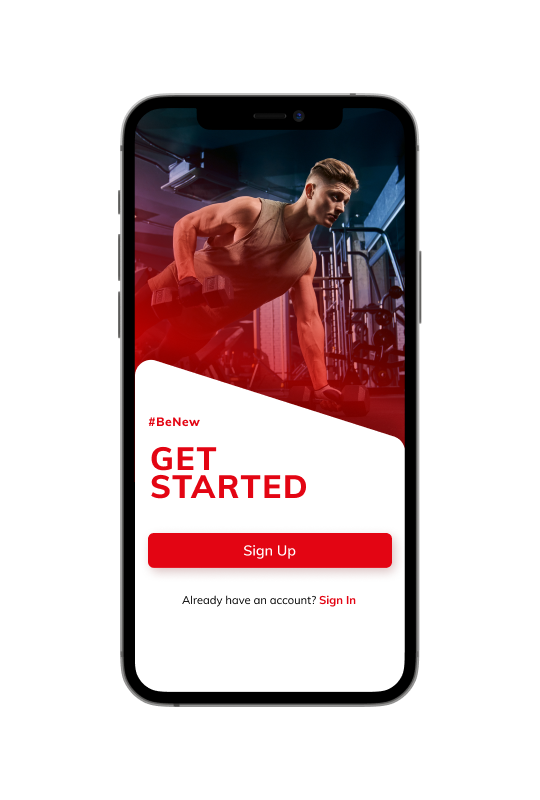


Gaurav Patil